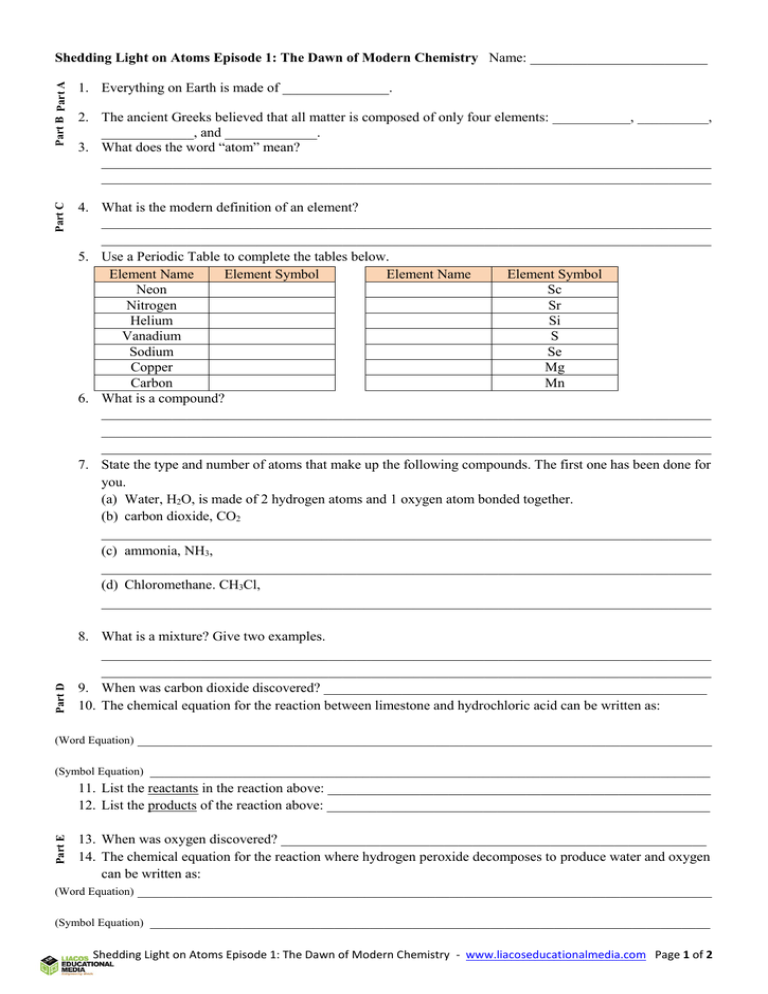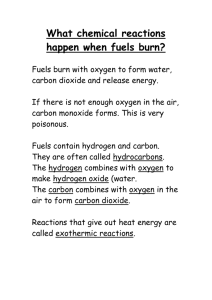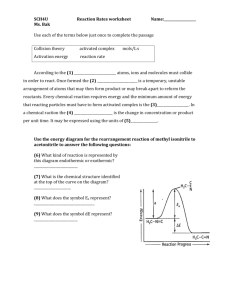1. Everything on Earth is made of _______________.
advertisement

Part B Part A 4. What is the modern definition of an element? ______________________________________________________________________________________ ______________________________________________________________________________________ 5. Use a Periodic Table to complete the tables below. Element Name Element Symbol Element Name Element Symbol Neon Sc Nitrogen Sr Helium Si Vanadium S Sodium Se Copper Mg Carbon Mn 6. What is a compound? ______________________________________________________________________________________ ______________________________________________________________________________________ ______________________________________________________________________________________ 7. State the type and number of atoms that make up the following compounds. The first one has been done for you. (a) Water, H2O, is made of 2 hydrogen atoms and 1 oxygen atom bonded together. (b) carbon dioxide, CO2 ______________________________________________________________________________________ (c) ammonia, NH3, ______________________________________________________________________________________ (d) Chloromethane. CH3Cl, ______________________________________________________________________________________ Part D 1. Everything on Earth is made of _______________. Part C Shedding Light on Atoms Episode 1: The Dawn of Modern Chemistry Name: _________________________ 2. The ancient Greeks believed that all matter is composed of only four elements: ___________, __________, _____________, and _____________. 3. What does the word “atom” mean? ______________________________________________________________________________________ ______________________________________________________________________________________ 8. What is a mixture? Give two examples. ______________________________________________________________________________________ ______________________________________________________________________________________ 9. When was carbon dioxide discovered? ______________________________________________________ 10. The chemical equation for the reaction between limestone and hydrochloric acid can be written as: (Word Equation) _________________________________________________________________________________ _______________________________________________________________________________ 11. List the reactants in the reaction above: ______________________________________________________ 12. List the products of the reaction above: ______________________________________________________ Part E (Symbol Equation) 13. When was oxygen discovered? ____________________________________________________________ 14. The chemical equation for the reaction where hydrogen peroxide decomposes to produce water and oxygen can be written as: (Word Equation) _________________________________________________________________________________ (Symbol Equation) _______________________________________________________________________________ Shedding Light on Atoms Episode 1: The Dawn of Modern Chemistry - www.liacoseducationalmedia.com Page 1 of 2 15. The manganese dioxide did not chemically react but instead acted as a “catalyst”. What is a catalyst? ______________________________________________________________________________________ ______________________________________________________________________________________ ______________________________________________________________________________________ 16. To start a fire, you need three things: (a) A fuel. List three examples. ____________________________________________________________ (b) Oxygen, and (c) ________________ List three examples. _________________________________________________ __________________________________________________________________________________ 17. What is the “ignition temperature” of a fuel? ______________________________________________________________________________________ ______________________________________________________________________________________ 18. Why is water so good at putting out wood fires? (There are two reasons) ______________________________________________________________________________________ ______________________________________________________________________________________ ______________________________________________________________________________________ Skill-Building Exercise: Writing Chemical Equations 19. Use the information below to write word equations. (a) Methane chemically reacts with oxygen (when it burns) to produce carbon dioxide and water. ______________________________________________________________________________________ (b) Calcium hydroxide and hydrogen are produced when calcium chemically reacts with water. ______________________________________________________________________________________ 20. Use the information below to write word and symbol equations. Copper carbonate (CuCO3) breaks apart and produces carbon dioxide (CO2) and copper oxide (CuO). (This occurs when it is heated.) (Word Equation) _________________________________________________________________________________ _______________________________________________________________________________ 21. Tin oxide (SnO2) is produced when tin (Sn) chemically reacts with oxygen (O2). (Word Equation) _________________________________________________________________________________ (Symbol Equation) _______________________________________________________________________________ Skill-Building Exercise: Balancing Chemical Equations The balanced chemical equation for the hydrogen peroxide reaction above is 2H2O2 O2 + 2H2O. 22. The expression 2H2O in the chemical equation indicates two separate water molecules are produced which represents a total of _____ H atoms and _____ O atoms. 23. The expression 2H2O2 in the chemical equation indicates two separate hydrogen peroxide molecules which represents a total of _____ H atoms and _____ O atoms. When balancing equations, it’s best simply to balance the first atom you come across first and then the second atom and so on. Balance the following equations. 24. ____ H2 + ____ Cl2 ____ HCl H H Cl + Cl H Cl (Symbol Equation) (Draw extra diagrams if you need to) (If you only need 1 of something, you don’t need to write the number in) H 25. ____ N2 + ____ H2 ____ NH3 (Draw extra diagrams if you need to) 26. 27. 28. 29. N N + H H N H H ____ Li + ____ S ____ Li2S ____ K + ____ Cl2 ____ KCl ____ Ca + ____ O2 ____ CaO ____ Na + ____O2 ____Na2O Note: Why do H2O, CaO, and CO2 exist, while there is no such thing as H3O, HO2, C2O or CaO2 for example? The reason that atoms bond together only in certain combinations has not been covered yet. But it will be! Shedding Light on Atoms Episode 1: The Dawn of Modern Chemistry - www.liacoseducationalmedia.com Page 2 of 2






